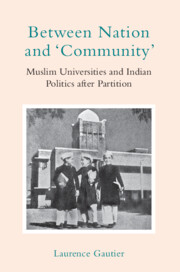Book contents
- Frontmatter
- Dedication
- Contents
- List of figures
- List of tables
- Acknowledgements
- A note on transliteration and translation
- List of abbreviations
- Introduction
- 1 A laboratory for composite India: Jamia Millia Islamia around the time of partition
- 2 Sifting Sir Syed’s legacy: From the ‘arsenal of Muslim India’ to a symbol of India’s national integration?
- 3 Re-legitimising minority rights: The campaign for Aligarh Muslim University’s minority status
- 4 Resisting minority politics, holding on to composite nationalism: Jamia Millia Islamia in the post-Nehruvian period
- 5 Uplifting backward Muslims: The new consensus?
- 6 Bastions of Islam: The defence of Islam as a narrative of empowerment and contestation
- 7 Women in Muslim universities: Guardians of tradition or actors of change?
- Conclusion
- Appendix
- Glossary
- Bibliography
- Index
2 - Sifting Sir Syed’s legacy: From the ‘arsenal of Muslim India’ to a symbol of India’s national integration?
Published online by Cambridge University Press: 15 April 2024
- Frontmatter
- Dedication
- Contents
- List of figures
- List of tables
- Acknowledgements
- A note on transliteration and translation
- List of abbreviations
- Introduction
- 1 A laboratory for composite India: Jamia Millia Islamia around the time of partition
- 2 Sifting Sir Syed’s legacy: From the ‘arsenal of Muslim India’ to a symbol of India’s national integration?
- 3 Re-legitimising minority rights: The campaign for Aligarh Muslim University’s minority status
- 4 Resisting minority politics, holding on to composite nationalism: Jamia Millia Islamia in the post-Nehruvian period
- 5 Uplifting backward Muslims: The new consensus?
- 6 Bastions of Islam: The defence of Islam as a narrative of empowerment and contestation
- 7 Women in Muslim universities: Guardians of tradition or actors of change?
- Conclusion
- Appendix
- Glossary
- Bibliography
- Index
Summary
To me the work at Aligarh signified no less than the handling at one of the most significant centres of the chief problem with which Indian statesmanship is faced—the problem of an integrated nationhood in a secular democratic state…. The despondent Muslim masses are scattered all over the country. We can dissipate the efforts to revive hope and faith in them. But if we do something significant at Aligarh it can electrify them.
—Zakir Husain to Rajendra Prasad, 19 July 19501After independence, the Indian government tended to project JMI primarily as an experimental institution à la Gandhi, focused on basic education and social reform. Although religion played a central part in JMI's ethos, the government was more likely to compare JMI to Visva Bharati, Tagore's experimental school in rural Bengal, than to AMU. AMU, by contrast, appeared to be the Muslim university par excellence. For many Muslims, it was a source of pride and a symbol of Indian Muslim culture. The institution epitomised Sayyid Ahmad Khan's efforts to uplift the community and preserve the legacy of the glorious Mughal past. However, due to the widespread support of teachers and students for the Muslim League in the 1940s, the university also came to be seen, in certain quarters, as a symbol of Muslim separatism. Long after the riots had ceased, it remained a lieu de mémoire of partition, crystallising resentment against Muslims’ supposedly communal and disloyal attitude.
Despite this prejudice, Zakir Husain strongly believed that AMU could contribute, more than JMI, to the development of an ‘integrated nationhood’. It was precisely because of its legacy as a centre of Muslim politics and educational reform that the university could, he believed, channel the efforts to ‘revive hope and faith’ among the ‘despondent Muslim masses’ and help them feel part of India's ‘secular democratic state’.
A few Congress leaders, particularly Nehru and Azad, shared a similar vision of the university's mission in post-independence India. In 1951, AMU became, along with Banaras Hindu University (BHU), one of the three central universities under the control of the central government. For Nehru, it was essential to ensure that, despite partition, Indian Muslims would feel part of the Indian nation in order to build a secular stat
- Type
- Chapter
- Information
- Between Nation and ‘Community'Muslim Universities and Indian Politics after Partition, pp. 90 - 136Publisher: Cambridge University PressPrint publication year: 2025



